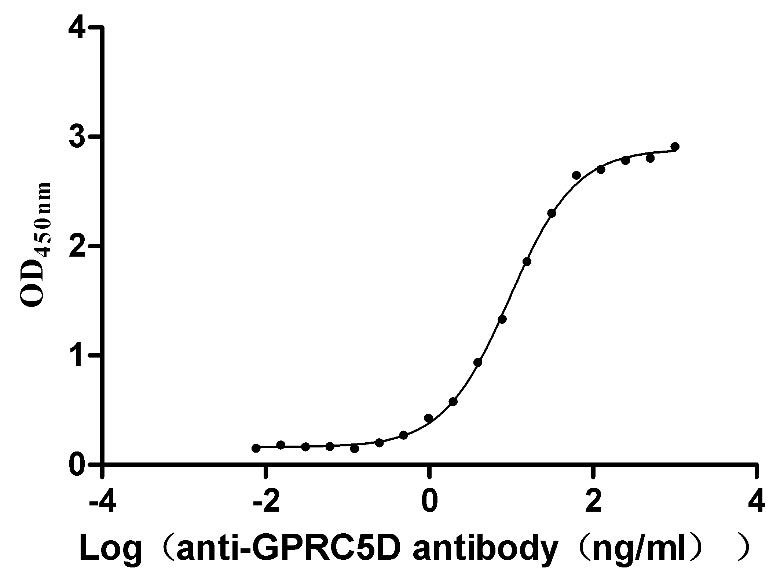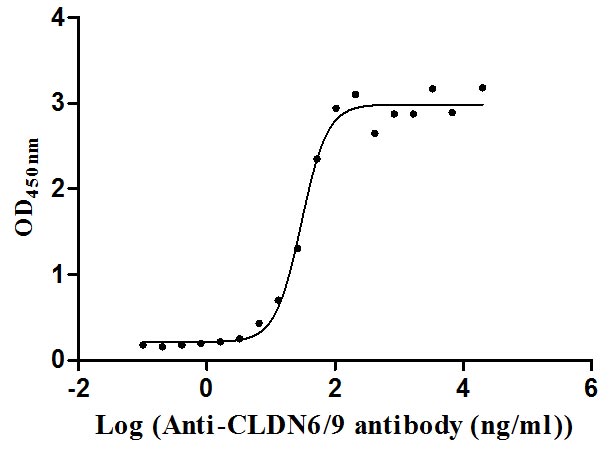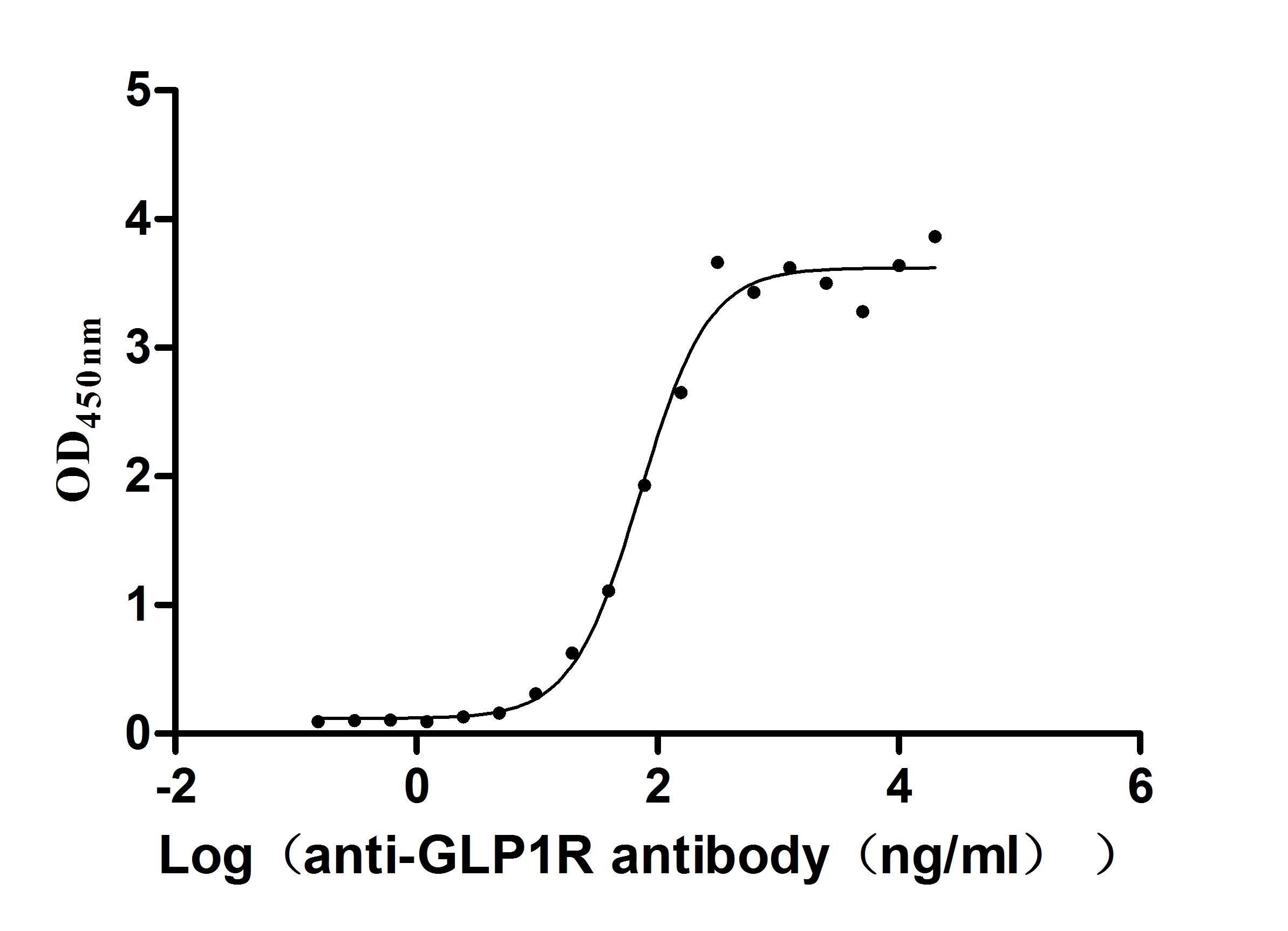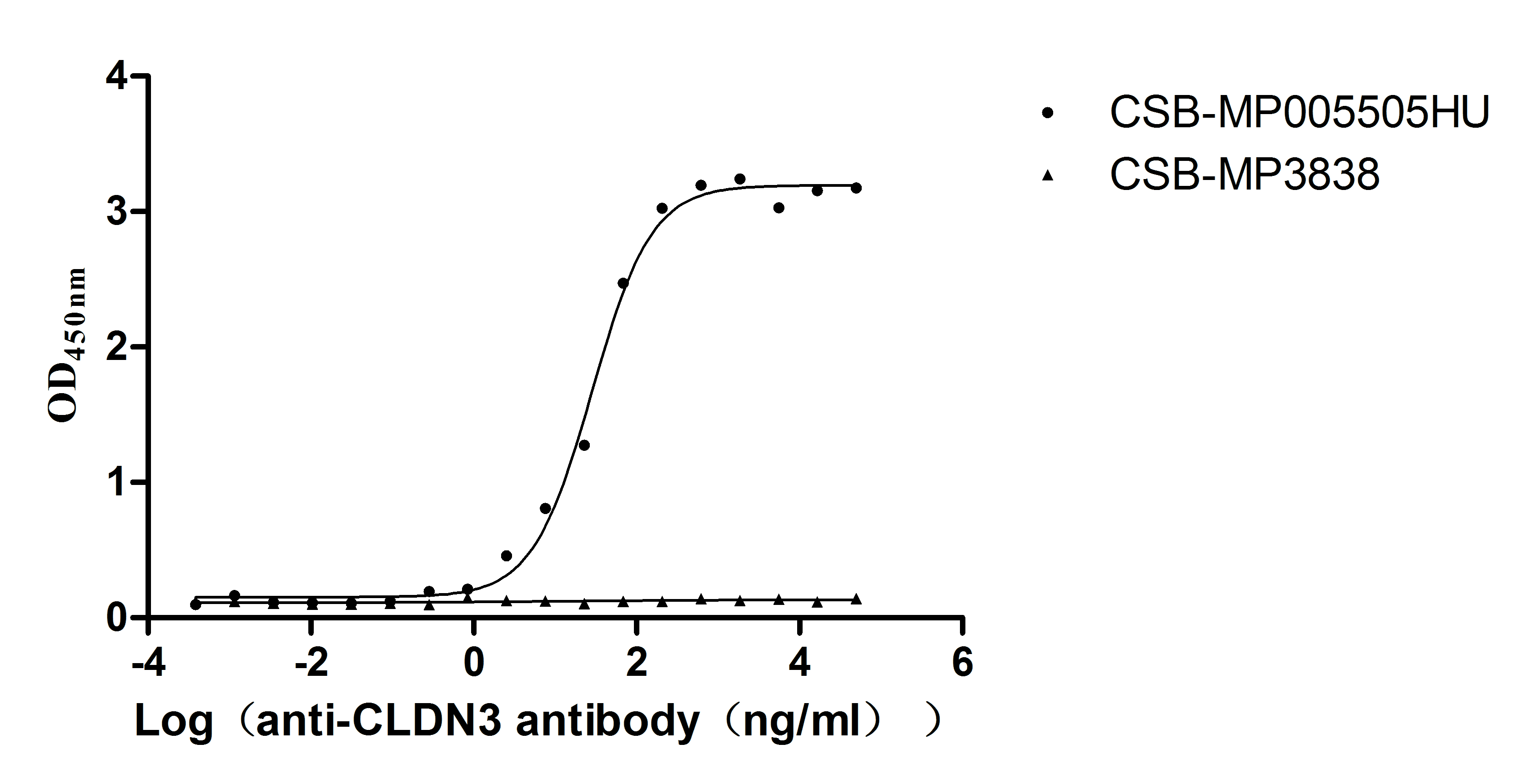Recombinant Human HLA class I histocompatibility antigen, B alpha chain (HLA-B), partial
-
中文名称:人HLA-B重组蛋白
-
货号:CSB-YP355776HU
-
规格:
-
来源:Yeast
-
其他:
-
中文名称:人HLA-B重组蛋白
-
货号:CSB-EP355776HU-B
-
规格:
-
来源:E.coli
-
共轭:Avi-tag Biotinylated
E. coli biotin ligase (BirA) is highly specific in covalently attaching biotin to the 15 amino acid AviTag peptide. This recombinant protein was biotinylated in vivo by AviTag-BirA technology, which method is BriA catalyzes amide linkage between the biotin and the specific lysine of the AviTag.
-
其他:
-
中文名称:人HLA-B重组蛋白
-
货号:CSB-BP355776HU
-
规格:
-
来源:Baculovirus
-
其他:
-
中文名称:人HLA-B重组蛋白
-
货号:CSB-MP355776HU
-
规格:
-
来源:Mammalian cell
-
其他:
产品详情
-
纯度:>85% (SDS-PAGE)
-
基因名:
-
Uniprot No.:
-
别名:1B07_HUMAN; AS; B-4901; B-7 alpha chain; HC class I antigen SHCHA; HLA class I histocompatibility antigen; HLA class I histocompatibility antigen, B alpha chain; HLA-B; HLA-B histocompatibility type; HLAB; leukocyte antigen class I-B; major histocompatibility complex, class I, B; MHC class 1 antigen; MHC class I antigen B*7; MHC class I antigen HLA-B alpha chain; MHC class I antigen HLA-B heavy chain; MHC Class I HLA heavy chain; MHC class I molecule; MHC HLA-B cell surface glycoprotein; MHC HLA-B transmembrane glycoprotein; SPDA1
-
种属:Homo sapiens (Human)
-
蛋白长度:Partial
-
蛋白标签:Tag type will be determined during the manufacturing process.
The tag type will be determined during production process. If you have specified tag type, please tell us and we will develop the specified tag preferentially. -
产品提供形式:Lyophilized powder
Note: We will preferentially ship the format that we have in stock, however, if you have any special requirement for the format, please remark your requirement when placing the order, we will prepare according to your demand. -
复溶:We recommend that this vial be briefly centrifuged prior to opening to bring the contents to the bottom. Please reconstitute protein in deionized sterile water to a concentration of 0.1-1.0 mg/mL.We recommend to add 5-50% of glycerol (final concentration) and aliquot for long-term storage at -20℃/-80℃. Our default final concentration of glycerol is 50%. Customers could use it as reference.
-
储存条件:Store at -20°C/-80°C upon receipt, aliquoting is necessary for mutiple use. Avoid repeated freeze-thaw cycles.
-
保质期:The shelf life is related to many factors, storage state, buffer ingredients, storage temperature and the stability of the protein itself.
Generally, the shelf life of liquid form is 6 months at -20°C/-80°C. The shelf life of lyophilized form is 12 months at -20°C/-80°C. -
货期:Delivery time may differ from different purchasing way or location, please kindly consult your local distributors for specific delivery time.Note: All of our proteins are default shipped with normal blue ice packs, if you request to ship with dry ice, please communicate with us in advance and extra fees will be charged.
-
注意事项:Repeated freezing and thawing is not recommended. Store working aliquots at 4°C for up to one week.
-
Datasheet :Please contact us to get it.
相关产品
靶点详情
-
功能:Antigen-presenting major histocompatibility complex class I (MHCI) molecule. In complex with B2M/beta 2 microglobulin displays primarily viral and tumor-derived peptides on antigen-presenting cells for recognition by alpha-beta T cell receptor (TCR) on HLA-B-restricted CD8-positive T cells, guiding antigen-specific T cell immune response to eliminate infected or transformed cells. May also present self-peptides derived from the signal sequence of secreted or membrane proteins, although T cells specific for these peptides are usually inactivated to prevent autoreactivity. Both the peptide and the MHC molecule are recognized by TCR, the peptide is responsible for the fine specificity of antigen recognition and MHC residues account for the MHC restriction of T cells. Typically presents intracellular peptide antigens of 8 to 13 amino acids that arise from cytosolic proteolysis via constitutive proteasome and IFNG-induced immunoproteasome. Can bind different peptides containing allele-specific binding motifs, which are mainly defined by anchor residues at position 2 and 9.; Allele B*07:02: Displays peptides sharing a common signature motif, namely a Pro residue at position 2 and mainly a Leu anchor residue at the C-terminus. Presents a long peptide (APRGPHGGAASGL) derived from the cancer-testis antigen CTAG1A/NY-ESO-1, eliciting a polyclonal CD8-positive T cell response against tumor cells. Presents viral epitopes derived from HIV-1 gag-pol (TPQDLNTML) and Nef (RPQVPLRPM). Presents an immunodominant epitope derived from SARS-CoV-2 N/nucleoprotein (SPRWYFYYL). Displays self-peptides including a peptide derived from the signal sequence of HLA-DPB1 (APRTVALTA).; Allele B*08:01: Presents to CD8-positive T cells viral epitopes derived from EBV/HHV-4 EBNA3 (QAKWRLQTL), eliciting cytotoxic T cell response.; Allele B*13:02: Presents multiple HIV-1 epitopes derived from gag (RQANFLGKI, GQMREPRGSDI), nef (RQDILDLWI), gag-pol (RQYDQILIE, GQGQWTYQI) and rev (LQLPPLERL), all having in common a Gln residue at position 2 and mainly hydrophobic amino acids Leu, Ile or Val at the C-terminus. Associated with succesful control of HIV-1 infection.; Allele B*18:01: Preferentially presents octomeric and nonameric peptides sharing a common motif, namely a Glu at position 2 and Phe or Tyr anchor residues at the C-terminus. Presents an EBV/HHV-4 epitope derived from BZLF1 (SELEIKRY). May present to CD8-positive T cells an antigenic peptide derived from MAGEA3 (MEVDPIGHLY), triggering an anti-tumor immune response. May display a broad repertoire of self-peptides with a preference for peptides derived from RNA-binding proteins.; Allele B*27:05: Presents to CD8-positive T cells immunodominant viral epitopes derived from HCV POLG (ARMILMTHF), HIV-1 gag (KRWIILGLNK), IAV NP (SRYWAIRTR), SARS-CoV-2 N/nucleoprotein (QRNAPRITF), EBV/HHV-4 EBNA4 (HRCQAIRKK) and EBV/HHV-4 EBNA6 (RRIYDLIEL), confering longterm protection against viral infection. Can present self-peptides derived from cytosolic and nuclear proteins. All peptides carry an Arg at position 2. The peptide-bound form interacts with NK cell inhibitory receptor KIR3DL1 and inhibits NK cell activation in a peptide-specific way, being particularly sensitive to the nature of the amino acid side chain at position 8 of the antigenic peptide. KIR3DL1 fails to recognize HLA-B*27:05 in complex with B2M and EBV/HHV-4 EBNA6 (RRIYDLIEL) peptide, which can lead to increased activation of NK cells during infection. May present an altered repertoire of peptides in the absence of TAP1-TAP2 and TAPBPL.; Allele B*40:01: Presents immunodominant viral epitopes derived from EBV/HHV-4 LMP2 (IEDPPFNSL) and SARS-CoV-2 N/nucleoprotein (MEVTPSGTWL), triggering memory CD8-positive T cell response. Displays self-peptides sharing a signature motif, namely a Glu at position 2 and a Leu anchor residue at the C-terminus.; Allele B*41:01: Displays self-peptides sharing a signature motif, namely a Glu at position 2 and Ala or Pro anchor residues at the C-terminus.; Allele B*44:02: Presents immunodominant viral epitopes derived from EBV/HHV-4 EBNA4 (VEITPYKPTW) and EBNA6 (AEGGVGWRHW, EENLLDFVRF), triggering memory CD8-positive T cell response. Displays self-peptides sharing a signature motif, namely a Glu at position 2 and Phe, Tyr or Trp anchor residues at the C-terminus.; Allele B*45:01: Displays self-peptides sharing a signature motif, namely a Glu at position 2 and Ala or Pro anchor residues at the C-terminus.; Allele B*46:01: Preferentially presents nonameric peptides sharing a signature motif, namely Ala and Leu at position 2 and Tyr, Phe, Leu, or Met anchor residues at the C-terminus. The peptide-bound form interacts with KIR2DL3 and inhibits NK cell cytotoxic response in a peptide-specific way.; Allele B*47:01: Displays self-peptides sharing a signature motif, namely an Asp at position 2 and Leu or Met anchor residues at the C-terminus.; Allele B*49:01: Displays self-peptides sharing a signature motif, namely a Glu at position 2 and Ile or Val anchor residues at the C-terminus.; Allele B*50:01: Displays self-peptides sharing a signature motif, namely a Glu at position 2 and Ala or Pro anchor residues at the C-terminus.; Allele B*51:01: Presents an octomeric HIV-1 epitope derived from gag-pol (TAFTIPSI) to the public TRAV17/TRBV7-3 TCR clonotype, strongly suppressing HIV-1 replication.; Allele B*54:01: Displays peptides sharing a common signature motif, namely a Pro residue at position 2 and Ala anchor residue at the C-terminus.; Allele B*55:01: Displays peptides sharing a common signature motif, namely a Pro residue at position 2 and Ala anchor residue at the C-terminus.; Allele B*56:01: Displays peptides sharing a common signature motif, namely a Pro residue at position 2 and Ala anchor residue at the C-terminus.; Allele B*57:01: The peptide-bound form recognizes KIR3DL1 and inhibits NK cell cytotoxic response.; Allele B*67:01: Displays peptides sharing a common signature motif, namely a Pro residue at position 2 and Leu anchor residue at the C-terminus.
-
基因功能参考文献:
- The HLA-B35 allele was significantly more common in patients with rheumatic heart disease than the control group (P = 0.043). The HLA-B44 allele was significantly more common in control patients than in patients with rheumatic heart disease (P = 0.014). PMID: 30119146
- Studied the association of interferon-lambda 4 (IFNL4)-related polymorphisms and human leukocyte antigen (HLA)-B haplotypes within long-term nonprogressor HIV-1 controllers (LTNP-Cs); HLA-B*57 was independently associated with the LTNP-C phenotype, while IFNL4 genotypes represented independent factors for becoming non-LTNP-C. PMID: 27986689
- The present work showed in West Algerian population that the HLA-B27 antigen and the variation in the CTLA4 3'UTR region played an important role in the ankylosing spondylitis susceptibility. The heterogeneity of this disease is deduced by genetic difference found between B27+ and B27- groups. PMID: 29675891
- results reveal strong evidence that the HLA-B*15:02 polymorphism can induce serious cutaneous reactions among Asian carbamazepine users[review, meta-analysis] PMID: 29685430
- human leukocyte antigen (HLA)-Bw4 is associated with susceptibility to psoriatic disease (PsD), but genetic interactions with their cognate ligand, variably expressed killer cell immunoglobulin like receptor (KIR) 3DL1 alleles PMID: 28801811
- The present study was conducted to investigate the key genes and the inflammatory signaling pathways involved in HLA-B27-associated acute anterior uveitis (AAU) families. PMID: 29620146
- rs12524487 in HLA-B/MICA was a genetic risk factor for Takayasu arteritis in a Chinese Han population and rs9366782 in this region was associated with ischemic brain disease in TA but not TA susceptibility. PMID: 28261975
- Ankylosing spondylitis (AS) patients with B*2704 have a higher risk of uveitis than AS with B*2705 in a north Chinese people. PMID: 27428175
- this study demonstrates an association between HLA-B alleles and carbamazepine-induced maculopapular exanthema and severe cutaneous reactions in Thai patients PMID: 29546073
- Significant association between the HLA-B*15:02 genotype and the B-75(15) serotype and carbamazepine-induced Stevens-Johnson syndrome/toxic epidermal necrolysis in Javanese and Sundanese populations. PMID: 29053440
- this study shows that HLA-B genetic variance is associated with HIV-1 viral load in seroconverters from Zambia and Rwanda PMID: 29289742
- This analysis showed that HLA-B*58:01 genetic testing before allopurinol initiation is unlikely to be a cost-effective intervention in Malaysia. PMID: 29176400
- Association of HLA-B*15:02 with phenytoin-induced SJS/TEN is rare in the population studied. PMID: 29076187
- The SNPs rs116488202 and rs4349859 may have a place in the identification of HLA-B27 in the Turkish population. PMID: 26200952
- HLA-B18 positive patients more frequently had a higher and faster fibrosis progression rate. PMID: 27241060
- Our results suggested, for the first time, that HLA-B*51:01 is a risk allele for clindamycin-related cutaneous adverse drug reactions in Han Chinese, especially when clindamycin is administered via intravenous drip. PMID: 27527109
- HLA-B18 Is risk factor of liver fibrosis progression in HIV/HCV treatment-experienced patients PMID: 27779247
- There is a strong association between HLA-B*27 and ankylosing spondylitis patients in the Kurdistan Region of Iraq. PMID: 26012363
- identification of theoretical epitopes (motifs) involved in the serological reactivity of several HLA-B*14 products. PMID: 28691368
- Review/Meta-analysis: Screening of HLA-B*5801 may help patients to prevent the occurrence of allopurinol-induced toxic epidermal necrolysis/Stevens-Johnsons syndrome, especially in populations with a higher (>/= 5%) risk allele frequency. PMID: 28857441
- The Zhuang population that had the highest frequency of HLA-B*15:02 antigens in China is at high risk for carbamazepine-related Stevens-Johnson syndrome toxic epidermal necrolysis disorder. PMID: 28205426
- current meta-analysis indicates that HLA-B27, especially, its subtypes (HLA-B27*02 and HLA-B27*04) may be potential risk factors for ankylosing spondylitis PMID: 28526894
- Alleles B*07, DRB1*07, DRB1*12, and C*03:02 provided the strongest associations with BMI in a healthy Chinese cohort. PMID: 29483183
- Comparison of the structures reveals that the two TCRs differentially binds NY-ESO-160-72-HLA-B*07:02 complex, and induces differing extent of conformational change of the NY-ESO-160-72 epitope. PMID: 29531227
- Better licensing of KIR3DL1(+) NK cells in the presence of multiple HLA-Bw4 copies is beneficial prior to seroconversion whereas HLA-Bw4 80(T) may be beneficial during acute hepatitis C PMID: 28412292
- in the Iranian population, HLA-B*08 confers susceptibility to Graves' disease PMID: 28919585
- Studied prevalence of HLA-B*5701 allele in HIV-infected children and its association with Abacavir hypersensitivity. PMID: 29242412
- The immunodominant HLA-B*27:02-restricted Nef response adds to protection mediated by the Gag and Pol specificities that dominate anti-HIV CD8(+) T-cell activity in HLA-B*27:05-positive subjects. PMID: 29167337
- demonstrates that individuals who are HLA-B *35:02 carriers are at increased risk of developing minocycline related liver injury PMID: 28323125
- study demonstrated an association between HLA-B*13:01 and dapsone-induced severe cutaneous adverse reactions including Stevens-Johnson syndrome/toxic epidermal necrolysis and drug reaction with eosinophilia and systemic symptoms in nonleprosy patients PMID: 28885988
- This study showed that distinct genetic markers were associated with phenotype-specific PHT-induced severe cutaneous adverse drug reactions. HLA-B*13:01, HLA-B*56:02/04, and CYP2C19*3 were potential genetic markers of phenytoin-induced drug rash with eosinophilia and systemic symptoms/drug hypersensitivity syndrome in Thai patients. PMID: 28391407
- The HLA-DRB1*15:01 allele was confirmed to be linked to multiple sclerosis disease in an Italy family. PMID: 28676141
- In white European people, antithyroid drug-induced agranulocytosis was associated with HLA-B*27:05 and with other SNPs on chromosome 6. PMID: 27157822
- Crystal structure of HLA-B*5801, a protective HLA allele for HIV-1 infection PMID: 27638468
- we found for the fi rst time an association between HLA genes and 25OHD concentration. Our results will need to be con fi rmed in a larger sample and preferably with more extensive HLA genotyping (in particular, HLA-A and HLA-C alleles). PMID: 27623983
- These data implicate the prevalent African allele HLA-B*53:01 in the immunopathogenesis of raltegravir-induced DRESS syndrome. PMID: 28369189
- Genetically, the strong primary sclerosing cholangitis (PSC) risk factors HLA-B*08 and DRB1*03 were more prevalent in Antineutrophil cytoplasmic antibodies (ANCA) -positive than -negative patients. In UC patients without liver disease, HLA-DRB1*03 was more prevalent in pANCA-positive compared with -negative patients.Antineutrophil cytoplasmic antibodies identified PSC patients with clinical and genetic characteristics. PMID: 27558072
- This review focuses on the ambivalent role of HLA-B27 in autoimmunity and viral protection correlating its functions to the quantitative and qualitative effects of ERAP1 and ERAP2 polymorphisms on their enzymatic activity. PMID: 28759104
- The association between HLA-B*57 and pemphigus vulgaris is reported for the first time in the present study. PMID: 28197992
- Arginine (di)methylated human leukocyte antigen class I peptides, which are asymmetrically dimethylated, most likely by CARM1, are favorably presented by HLA-B*07. PMID: 27503676
- This study demonstrated that the expression of a single human class I MHC molecule, independent of persistent virus infection, influences the extent of sub frequent chronic neuronal injury or repair in the absence of a class II MHC immune response. PMID: 27855706
- The HLA-B*50 allele was associated with conversion to myasthenia gravis generalized disease in patients with pure ocular symptoms at disease onset. PMID: 27802446
- A significantly higher risk of chronic rejection after kidney transplantation was observed when recipient (r) and donor (d) pairs completely lacked the two functional rKIR-dHLA ligand combinations rKIR2DL1/dHLA-C2 and rKIR3DL1/dHLA-Bw4. PMID: 28686681
- The HLA-B*42, HLA-C*17, HLA-DPA1*03, and HLA-DPB1*105 genotypes were associated with allergic asthma and the HLA-B*48 genotype with the nonallergic phenotype. PMID: 28380482
- There was no increased risk of rheumatoid arthritis in mothers of children with aspartic acid at position 9 of HLA-B. PMID: 28391248
- HLA-B*15:13 and HLA-B*15:02 are associated with phenytoin-induced severe cutaneous adverse reactions in a Malay population. PMID: 26927288
- The study found a strong association between the presence of HLA-B27 and the diagnosis of axial spondyloarthritis (axSpA) and ankylosing spondylitis (AS), but the HLA-B15 is also significantly associated with all subtypes of the disease, predominantly with peripheral spondyloarthritis (pSpA). Additionally, HLA-DR1 and DR4 were associated in a cohort of patients with SpA from Colombia. PMID: 28013432
- selecting a MICA-matched donor significantly influences key clinical outcomes of HCT in which a marked reduction of GVHD is paramount. The tight linkage disequilibrium between MICA and HLA-B renders identifying a MICA-matched donor readily feasible in clinical practice. PMID: 27549307
- HLA-B51 is a primary association marker in predisposition to Behcet disease, with IL-23R and IL12A being the additional strongest loci. PMID: 27548383
- B*07 allele was over represented in cutaneous leishmaniasis patients. PMID: 27301744
显示更多
收起更多
-
亚细胞定位:Cell membrane; Single-pass type I membrane protein. Endoplasmic reticulum membrane; Single-pass type I membrane protein.
-
蛋白家族:MHC class I family
-
数据库链接:
Most popular with customers
-
Recombinant Macaca fascicularis Delta-like protein 3 (DLL3), partial (Active)
Express system: Mammalian cell
Species: Macaca fascicularis (Crab-eating macaque) (Cynomolgus monkey)
-
Recombinant Human Poliovirus receptor (PVR) (I340M), partial (Active)
Express system: Mammalian cell
Species: Homo sapiens (Human)
-
Recombinant Human Prolactin receptor (PRLR), partial (Active)
Express system: Mammalian cell
Species: Homo sapiens (Human)
-
Recombinant Human C-X-C chemokine receptor type 4 (CXCR4)-VLPs (Active)
Express system: Mammalian cell
Species: Homo sapiens (Human)
-
Recombinant Human G-protein coupled receptor family C group 5 member D (GPRC5D)-VLPs (Active)
Express system: Mammalian cell
Species: Homo sapiens (Human)
-
Recombinant Human Claudin-9 (CLDN9)-VLPs (Active)
Express system: Mammalian cell
Species: Homo sapiens (Human)
-
Recombinant Human Glucagon-like peptide 1 receptor (GLP1R), partial (Active)
Express system: Mammalian cell
Species: Homo sapiens (Human)
-
Recombinant Human Claudin-3 (CLDN3)-VLPs (Active)
Express system: Mammalian cell
Species: Homo sapiens (Human)


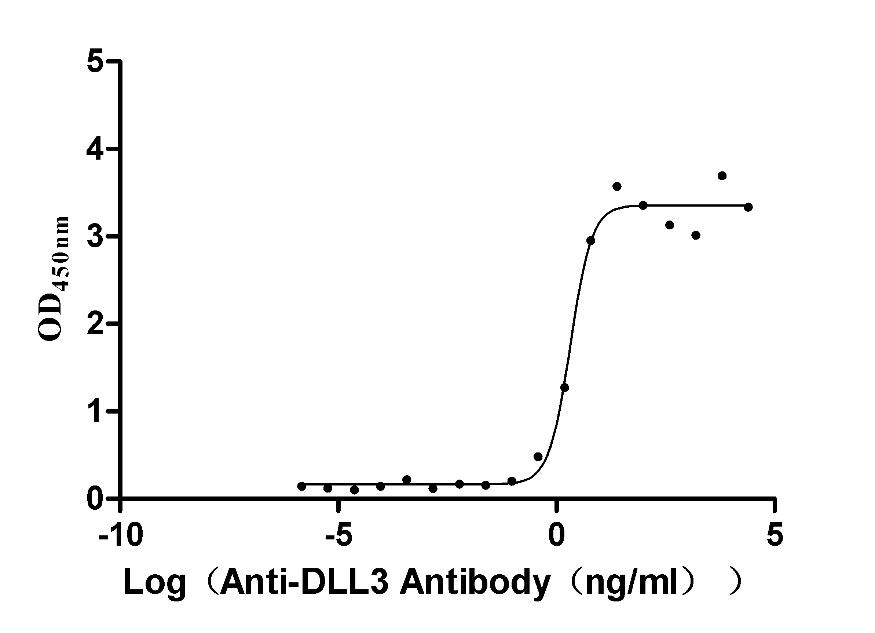
-AC1.jpg)
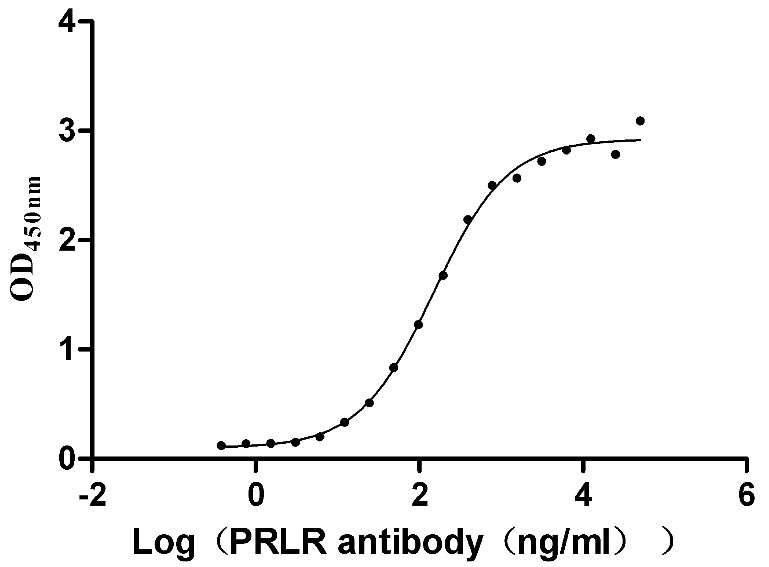
-AC1.jpg)
